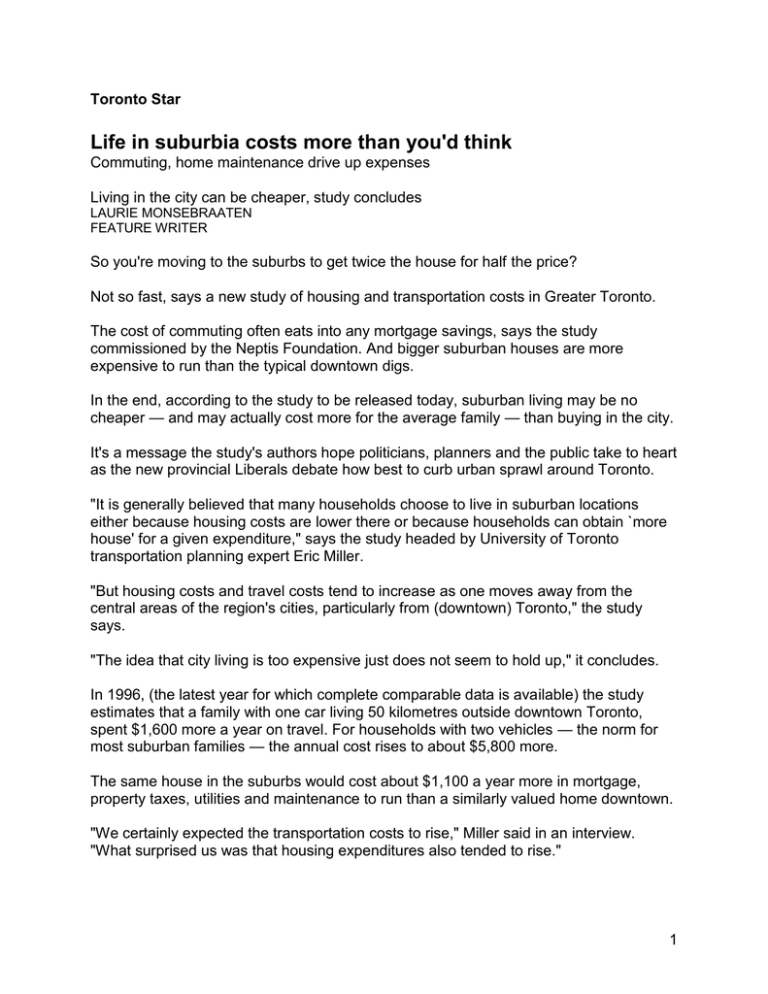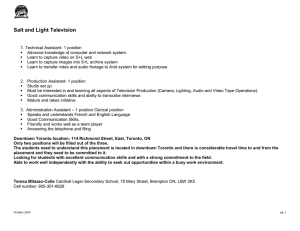
Toronto Star
Life in suburbia costs more than you'd think
Commuting, home maintenance drive up expenses
Living in the city can be cheaper, study concludes
LAURIE MONSEBRAATEN
FEATURE WRITER
So you're moving to the suburbs to get twice the house for half the price?
Not so fast, says a new study of housing and transportation costs in Greater Toronto.
The cost of commuting often eats into any mortgage savings, says the study
commissioned by the Neptis Foundation. And bigger suburban houses are more
expensive to run than the typical downtown digs.
In the end, according to the study to be released today, suburban living may be no
cheaper — and may actually cost more for the average family — than buying in the city.
It's a message the study's authors hope politicians, planners and the public take to heart
as the new provincial Liberals debate how best to curb urban sprawl around Toronto.
"It is generally believed that many households choose to live in suburban locations
either because housing costs are lower there or because households can obtain `more
house' for a given expenditure," says the study headed by University of Toronto
transportation planning expert Eric Miller.
"But housing costs and travel costs tend to increase as one moves away from the
central areas of the region's cities, particularly from (downtown) Toronto," the study
says.
"The idea that city living is too expensive just does not seem to hold up," it concludes.
In 1996, (the latest year for which complete comparable data is available) the study
estimates that a family with one car living 50 kilometres outside downtown Toronto,
spent $1,600 more a year on travel. For households with two vehicles — the norm for
most suburban families — the annual cost rises to about $5,800 more.
The same house in the suburbs would cost about $1,100 a year more in mortgage,
property taxes, utilities and maintenance to run than a similarly valued home downtown.
"We certainly expected the transportation costs to rise," Miller said in an interview.
"What surprised us was that housing expenditures also tended to rise."
1
But when you consider the larger homes and lot sizes in the suburbs, it makes sense
that it would cost more to maintain them, he said.
Miller and his team used Statistics Canada census information on household
expenditures, Toronto Real Estate Board data, automobile ownership surveys and
transportation studies for Hamilton, Halton, Peel, York, Toronto and Durham. And
although Miller was only able to obtain Statscan data from 1986 to 1996, he predicts
that as 2001 census information becomes available, the trend will continue.
"I think these trends will become more dramatic over time, especially with respect to
transportation costs," he said.
While the study didn't include the value of time spent travelling or the social and
environmental costs of sprawling development and traffic congestion, Miller said that
can't be ignored.
"If you are constantly travelling so you never have time to enjoy your backyard, what's
the point of having that backyard?" he said.
The study is one of a series commissioned by the independent, privately endowed
Neptis Foundation aimed at informing debate about urban issues affecting Greater
Toronto.
"One of the main questions the study raises is: Are there other options we should be
considering on the housing side?" Miller said. "Can we provide affordable housing
closer (to downtown) or in different ways to reduce some of those transportation costs?"
Denise Nicholson, 33 and her husband Rob, 38, were dismayed by the lack of housing
options in Toronto.
The couple, who were renting an apartment at Yonge St. and St. Clair Ave., had a baby
last March. "We were looking for a house around $350,000 to $400,000 tops. We were
looking at semi-detached houses with no garage, two bedrooms and a den they called
three bedrooms," Nicholson said. Since her husband had just started a job in Markham,
Nicholson suggested they look there.
They wound up getting twice the house for their money and are happy in their 2,200square-foot home in an established neighbourhood near Main St. and Highway
16.While her husband is much closer to work, the commute time — about 25 minutes —
is about the same as when he was travelling to Markham from midtown Toronto.
But Nicholson admits they are likely spending more to heat and maintain their Markham
home than they would have spent on a similarly priced house on a smaller Toronto lot.
"We've had to buy a lawn mower and patio furniture for the backyard," she said. "We've
also had to buy more furniture for the house."
The Neptis study acknowledges house price isn't the only reason people move to the
suburbs. Many people are attracted to the larger houses and more open space.
2
Kym Cronin, 37, and her husband Geoff, 42, are former Toronto residents who moved
to the suburbs for the lifestyle.
They moved from Mississauga when their first child was born 16 months ago, to be
close to Geoff's brother and his family.
"We could have bought a pretty nice house in Toronto for what we paid to live here, but
with the new baby and me home on maternity leave, we wanted to be closer to family,"
said Cronin, a film industry executive.
In fact, Cronin believes she has the best of both worlds. She's a 10-minute walk to the
Streetsville GO station, and can be at her desk in downtown Toronto within 40 minutes.
And the commute gives the new mom 30 minutes a day to read. On weekends, they are
just a 15-minute stroll to the old town of Streetsville, where there are nice shops and
good restaurants.
Miller says Streetsville, where there are both local options for pedestrian travel as well
as transit for longer trips, is an example of how new suburban communities should be
built.
Car travel is not necessarily evil, he said. In fact, for families, it's a reasonably efficient
way to travel. The problem " is that we have locked so many people into singleoccupancy car trips for so much of what we do and there are no other options," he said.
There will always be people who want their 50-foot lots and maybe they should have
them, Miller said. But maybe those lots aren't being priced properly.
"There's a strong argument to be made that a lot of this sprawl has gone on in a way
that is under-priced. True social costs are not being captured anywhere in the system."
Miller pointed to the United States, where several American lenders provide mortgage
incentives to families who live in energy-efficient homes near public transit.
In Canada, MP John Godfrey, responsible for the cities file, has said he thinks the
federal Canada Mortgage and Housing Corp. should be providing similar breaks for
Canadians who would like to live closer to downtown, but can't afford it.
Empty nesters David Dugas, 53, and his wife Carol, 45, are an example of a new trend
of suburbanites moving downtown.
They traded in their 3,000-square-foot Burlington home for a small Beach row house in
1999 and have no regrets.
Dugas figures they spend less on heating and maintaining their city house. But it's the
difference in car use that he notices. The owner and manager of a cleaning business
still drives to work, but no longer must travel on highways that can turn into a nightmare
in bad weather."When you live in the suburbs you have to jump in your car to go
3
anywhere," he said. "Here we can walk to see a movie and go to a restaurant. It's
great."
***
Copyright Toronto Star Newspapers Limited. All rights reserved.
** NOTICE: In accordance with Title 17 U.S.C. Section 107, this material is distributed,
without profit, for research and educational purposes only. **
4




